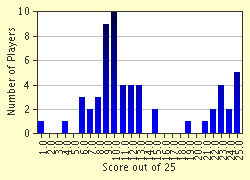Quiz Answer Key and Fun Facts
1. An easy question to start with: "Show Boat" was based on the book of the same name by this author.
2. Of the creative team that would produce "Show Boat", who was the first to read the book and conceive the idea of turning it into a musical?
3. Florenz Ziegfeld had grave misgivings about producing "Show Boat" and agreed to do so only with great reluctance.
4. How great a time span does the show (as opposed to the book) cover?
5. Which song, now a long-established classic, did Ziegfeld greatly dislike during rehearsals.
6. Paul Robeson created the role of Joe in the 1927 Broadway premiere of "Show Boat".
7. The role of Cap'n Andy has been performed by Joe E. Brown, David Wayne, Donald O' Conner, Gail Gordon, Eddie Bracken, Ned Beatty, Robert Morse, and John Mc Martin, among others. Who created the role in 1927?
8. At Ziegfeld's insistence, the song "Misery's Comin' Around" from act one was removed, although it has been reinstated in some recent productions. Where in the show does it occur?
9. The lyrics to the song "Bill" were written not by Hammerstein, but by P.G. Wodehouse.
10. In the first scene of the show, we learn that Gaylord Ravanel cannot legally stay more than 24 hours in town; we are not told the reason until the wedding scene. What is the reason?
11. Ravanel has four solos (as opposed to duets) in the show.
12. The great duet "You Are Love" replaced an earlier number for Ravanel and Magnolia entitled "The Creole Love Song".
13. Several different numbers were written for Kim's big solo in the last scene of the show. Which was the first to have been written (although it wasn't performed)?
14. None of the music in the Trocadero New year's Eve scene, as originally performed, was written by Kern.
15. In the original, how many times does Joe sing "Ol' Man River"?
16. What is the name of the melodrama being rehearsed during the "Miscegenation Scene", which is also performed later with Ravanel and Magnolia in the leads?
17. What other musical united Kern and Hammerstein with Helen Morgan, the original Julie?
18. This delightful number originally opened Act One, scene 5, but had to be cut because of the show's excessive length.
19. Which veteran actress, known to both stage and screen audiences, created the role of the formidible Parthy Ann Hawks? (Hint- she starred in a number of film versions of great novels.)
20. Which of these members of the original cast did NOT reprise his/her role for the 1936 film version?
21. The song "Why Do I Love You" is, on the surface, an ecstatic duet between the two lovers. What indication do we have during the song that all is not as blissful as it seems?
22. What song does Magnolia sing for her audition at the Trocadero Nighclub?
23. How many performances did the original run of "Show Boat" have?
24. Which two characters do a number called a "Ballyhoo"?
25. Which Broadway historian wrote a book on the origins and history of "Show Boat"?
Source: Author
jouen58
This quiz was reviewed by FunTrivia editor
ltc717 before going online.
Any errors found in FunTrivia content are routinely corrected through our feedback system.

